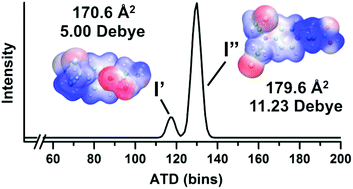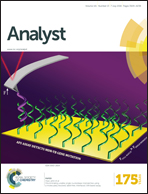Combining density functional theory (DFT) and collision cross-section (CCS) calculations to analyze the gas-phase behaviour of small molecules and their protonation site isomers†
Abstract
Electrospray ion mobility-mass spectrometry (IM-MS) data show that for some small molecules, two (or even more) ions with identical sum formula and mass, but distinct drift times are observed. In spite of showing their own unique and characteristic fragmentation spectra in MS/MS, no configurational or constitutional isomers are found to be present in solution. Instead the observation and separation of such ions appears to be inherent to their gas-phase behaviour during ion mobility experiments. The origin of multiple drift times is thought to be the result of protonation site isomers (‘protomers’). Although some important properties of protomers have been highlighted by other studies, correlating the experimental collision cross-sections (CCSs) with calculated values has proven to be a major difficulty. As a model, this study uses the pharmaceutical compound melphalan and a number of related molecules with alternative (gas-phase) protonation sites. Our study combines density functional theory (DFT) calculations with modified MobCal methods (e.g. nitrogen-based Trajectory Method algorithm) for the calculation of theoretical CCS values. Calculated structures can be linked to experimentally observed signals, and a strong correlation is found between the difference of the calculated dipole moments of the protomer pairs and their experimental CCS separation.

- This article is part of the themed collection: Ion Mobility Mass Spectrometry

 Please wait while we load your content...
Please wait while we load your content...